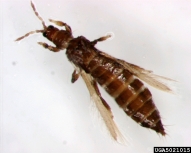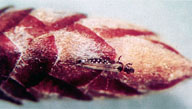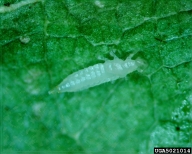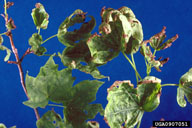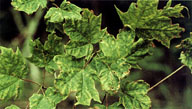Pear thrips
Taeniothrips inconsequences (Uzel) (Thysanoptera: Thripidae)
Orientation to pest
Pear thrips, Taeniothrips inconsequences (Uzel), is an invasive species in North America from Europe, first being recorded in the USA in California in 1900. Pear thrips have rasping/sucking mouthparts and use them to feed in early spring on buds and young leaves of hardwood trees. Potential for damage to sugar maples (Acer sacchrum Marshall) has been the greatest concern. Feeding injuries to embryonic or developing leaves result in mature leaves being deformed or tattered. Damage may spike in some years (e.g., the late 1980s) when thrips emerge earlier with respect to timing of bud break of key species, but such events are weather-dependent and do not occur regularly. In general the damage from this species is light.
Hosts commonly attacked
Sugar maples (Acer sacchrum Marshall) and other hardwoods
Distribution
No map available. The species is found in California, the northeast USA and southern Canada.
Images of pear thrips
| Figure 1. Adult pear thrips, Taeniothrips inconsequences | Figure 2. Larva of pear thrips |
| Figure 3. Leaf deformities on sugar maple due to feeding of pear thrips on buds | |
Important biological control agents related to this pest species
No specialized natural enemies of this thrips are known and the minor and irregular damage caused by this pest suggests that it is best left unmanaged or controlled only on limited acreage with pesticides if need be in years of unusually high damage.
Web links for information on pear thrips
- Fact Sheet | Pennsylvania State University Extension
- Sugar Maple and Pear Thrips Fact Sheet | Insect Diagnostic Laboratory, Cornell University
- Overview with Photos | USDA Forest Service, Northeastern Area
- 1999 Technical Report | Bartlett Tree Research Laboratories, Bartlett Tree Company
- 1993 NY Forest Owner Article | New York State, Department of Environmental Conservation
